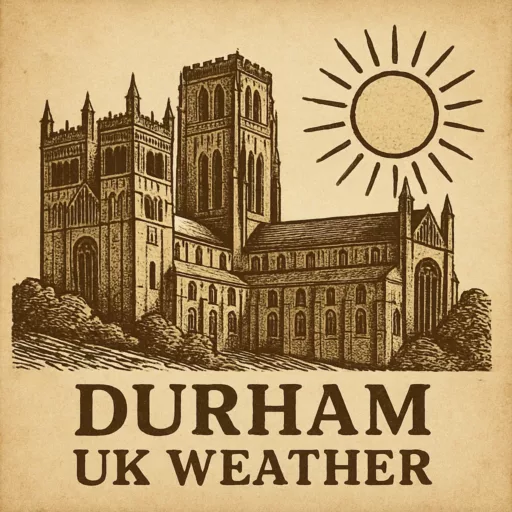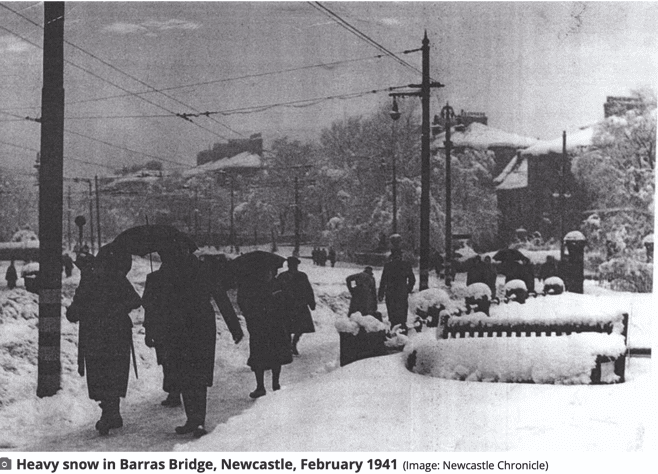Severe weather events in Durham, North East England
Just for a bit of fun, I asked ChatGPT to compile a Top 10 of severe weather events for North East England. I don’t think it did a bad job overall.
The weather is such a fascinating subject, isn’t it? Now, let me dive into the meteorological history of the North East of England for you. I’ve whipped up a quick top 10 list of some severe weather events. I’ll keep it to the point, but it’s still jam-packed with fun facts and tidbits.
1. The Big Freeze of 1963
Hands down, this has to be the coolest (pun intended) of the lot. January of 1963 was super frosty in North East England. The River Tyne was practically frozen solid! I’m picturing folks looking out of their windows thinking they’d woken up in Narnia.
This was not just a typical cold winter’s day or week; it’s one of those historical weather events that gets passed down through the generations, often brought up in conversations like, “You think this is cold? You should’ve seen ’63!”
The winter of 1962-1963, often referred to as the “Big Freeze of 1963,” was one of the coldest winters on record for the UK. It started with a bang around Boxing Day in 1962 and lasted until March 1963. Just imagine: nearly three solid months of intensely cold weather.
Here are some frosty comments about it:
- Snow Blanket: The UK was covered in snow for weeks. The snow depth reached astonishing levels, with some places buried under snow that was several feet deep.
- Frozen Rivers: This wasn’t just a bit of ice on a pond situation. Major rivers, including the River Tyne in the North East, froze. In some areas, people could walk across these frozen rivers, and there are even tales of impromptu fairs and games being held on the ice.
- Cold Temperatures: We’re talking about temperatures plunging down and refusing to come back up. Some areas experienced temperatures as low as -20°C (-4°F).
- Wildlife Impact: The prolonged cold had a significant impact on wildlife. Birds and mammals struggled to find food under the snow cover. Many birds, sadly, didn’t survive the harsh conditions.
- Human Endeavour: The Big Freeze also brought out the resilience and adaptability of people. With transportation routes disrupted due to the heavy snow, communities came together. Neighbors helped neighbors, children enjoyed extended holidays, and people found innovative ways to cope with the challenges.
- The Thaw: When temperatures finally began to rise in March 1963, it resulted in rapid thawing, which, as you might guess, led to significant flooding in several areas.
The Big Freeze of 1962-1963 is one of those landmark events that showcased the raw power of nature. It was a reminder of the unpredictability of weather and how, even in modern times, nature can still throw a curveball that disrupts daily life on a grand scale.
It’s fascinating, isn’t it? Weather events like these not only shape landscapes but also human experiences, stories, and memories. It’s no wonder that this winter has been etched into the annals of weather history and remains a hot topic (ironically) of conversation even decades later.
2. The Great Storm of 1987
Alright, technically this one battered the South more, but North East England got its fair share of gusty winds and rain. It’s known for the famous forecast by the weatherman Michael Fish. Oops. Nature sure has its surprises!
The 15th and 16th of October 1987 are dates etched in UK weather folklore. It’s one of those “Do you remember where you were when…?” kind of events for many folks in Britain.
Brewing of the Storm:
Leading up to the event, weather prediction models hinted at strong winds, but no one was quite prepared for what was to come. The English Channel, in particular, became a cauldron of meteorological mayhem.
The Infamous Forecast:
One of the most iconic moments associated with this storm is the forecast given by BBC weatherman Michael Fish on the evening of 15th October. With an air of casual dismissal, he stated, “Earlier on today, apparently, a woman rang the BBC and said she heard there was a hurricane on the way; well, if you’re watching, don’t worry, there isn’t…”. While he was technically correct (it wasn’t a hurricane by definition), the impending storm was still nothing to scoff at!
The Storm’s Wrath:
Winds roared at hurricane speeds, reaching up to 100mph in some areas. These winds, combined with heavy rainfall, created a tempestuous night. Trees, which still had many of their leaves due to a mild autumn, were especially vulnerable. An estimated 15 million trees were uprooted or damaged.
Impact:
- The severity of the storm caught everyone off guard. Roads and railways were blocked by fallen trees, making travel nigh impossible in many areas.
- Power lines came down, leaving thousands without electricity for more than 24 hours.
- Buildings, especially older structures, were severely damaged or destroyed.
- The cost of the damages was in the billions of pounds, making it one of the most expensive natural disasters in UK history.
- Tragically, the storm also claimed the lives of 18 people in England.
Aftermath and Learning:
In the wake of the storm, there was much introspection and review of how the Met Office and other agencies forecasted and communicated severe weather warnings. This event played a significant role in advancing the science of meteorology, improving predictive models, and refining how warnings are relayed to the public.
A Historical Perspective:
The Great Storm of 1987 is often compared to another historic storm that hit southern England in 1703, described by writer Daniel Defoe. The 1987 storm, while not as deadly as its predecessor, still stands as a stark reminder of nature’s unpredictability.
In retrospect, the storm was not just an event of meteorological significance but also of social and cultural importance. It became a watershed moment in weather forecasting in the UK, leading to substantial advancements in technology and methodology.
3. 2012 Flooding
Summer 2012 wasn’t exactly the sunniest for the North East. The region experienced many heavy rainfalls causing floods. Rivers burst their banks, roads were underwater, and, sadly, many homes were affected.
Background:
The summer of 2012 was a stark contrast to the traditional idea of warm, sunny days and BBQs in the park. June, in particular, was notably wetter than average, with parts of the UK receiving double the usual amount of rainfall. This heavy precipitation set the stage for the flooding events in the North East.
Sequence of Events:
- Heavy Rainfall: The weather systems coming off the Atlantic were especially laden with moisture. A series of persistent downpours affected parts of the region, saturating the ground and causing rivers to swell.
- River Overflow: Rivers such as the River Tyne, River Wear, and River Tees experienced significant rise in water levels. Unable to contain the excess water, they breached their banks, causing widespread flooding in adjacent areas.
- Urban Flooding: The urban areas weren’t spared either. Newcastle, among other towns and cities, faced severe urban flooding. Roads turned into rivers and cars were submerged, causing immense traffic disruptions.
- Infrastructure Damage: Roads, bridges, and rail lines suffered damage. This hampered rescue and relief efforts and also disrupted daily life and commerce for weeks.
- Residential Impact: Many homes were inundated, with residents forced to evacuate. The floods damaged property, personal belongings, and sadly, many people were displaced from their homes, some for extended periods.
- Economic Impact: Businesses, especially those on the riverbanks or in low-lying areas, suffered huge losses. The repair and recovery efforts also placed a financial strain on local authorities.
Response and Aftermath:
- Community Spirit: The silver lining in such events is often the incredible community response. Neighbors helped neighbors, people offered their homes to those displaced, and local groups organized assistance efforts.
- Emergency Services: The local emergency services, including fire brigades and police, worked tirelessly to rescue stranded individuals, evacuate threatened areas, and ensure the safety of the public.
- Recovery Efforts: Post the immediate threat, the focus shifted to recovery and rebuilding. Funds were allocated for repair works, and efforts were made to better prepare for future events.
- Re-evaluation of Flood Defenses: As with most significant flooding events, the 2012 floods led to discussions about the state of the UK’s flood defenses. Questions were raised about the adequacy of existing systems and whether more needed to be done to protect vulnerable areas.
The 2012 floods, like other major weather events, served as a poignant reminder of nature’s power. It was a testament to both the vulnerability of human-made infrastructures in the face of such events and the incredible resilience and unity of communities affected.
4. December 2010 Snowfall
Brrr! December 2010 was all about wrapping up in layers. The region experienced a proper white Christmas. It’s been reported that some places got over a foot of snow. Snowball fights must’ve been epic that year!
The winter of 2010 was one for the books, especially when it came to December. People dreaming of a white Christmas certainly got their wish that year!
Setting the Chilly Scene:
- Early Onset: While the UK is no stranger to cold snaps, December 2010 was remarkable not just for the intensity of the cold but for how early and suddenly winter set in. November had already set the tone with early snowfall in many parts of the country.
- Snow Blankets Everywhere: December 2010 was a continuation of this winter wonderland theme. Heavy snowfall was reported across many parts of the UK, with North East England being one of the hardest-hit areas.
- Record-breaking Cold: Along with the snow, the temperatures took a deep dive. Night-time temperatures were often well below freezing, and daytime temperatures weren’t much better. Some areas experienced temperatures as low as -10°C to -20°C.
The Snowy Impact:
- Travel Disruptions: As picturesque as the landscapes were, the snow caused widespread disruption, especially for travelers. Roads were slippery or blocked, trains faced severe delays, and flights were grounded.
- School Closures: Many children had an extended winter break as schools were closed due to the snow. While some might argue it was a festive bonus, parents probably had a different take!
- Infrastructure Challenges: Services like mail delivery and garbage collection faced interruptions. Power outages were also reported in certain areas.
- Community Bonding: Much like other severe weather events, the December 2010 snowfall brought communities together. Neighbors helped each other shovel snow, clear paths, and ensure the elderly and vulnerable were cared for.
Silver Linings and Snowy Fun:
- Snow Sports: For those into snow sports, it was a great time. Impromptu sledging tracks popped up everywhere. Snowball fights, snowman building competitions, and even igloo constructions were the order of the day.
- Picturesque Landscapes: For photographers, both amateur and professional, the snow provided a pristine, almost magical backdrop. The world transformed into a monochrome wonder, with pops of color from Christmas decorations and lights.
Reflection and Learning:
The December 2010 snowfall was a reminder of the importance of being prepared for severe weather events. It emphasized the need for robust infrastructure that can withstand such conditions and the importance of community in times of challenge.
Wrapping it up, December 2010 was a month that combined the challenges of severe weather with the joy and beauty of a winter wonderland. It was a time of cold noses, warm fires, community spirit, and snow-capped memories.
5. February 1941 Newcastle Blizzard
Imagine walking in whiteout conditions with winds howling in your ears. In February 1941, Newcastle was hit by such a blizzard. This one’s a classic!
Backdrop:
The early 1940s was a tumultuous time for the UK, given World War II’s ongoing impact. The hardships of war were further compounded by challenging weather events like the blizzard that hit Newcastle in February 1941.
Storming Into Action:
- Intense Snowfall: This blizzard wasn’t just a light dusting of snow – Newcastle and the surrounding areas were hit with heavy and persistent snowfall, leading to significant accumulations in a short span of time.
- Gusty Winds: The snow was accompanied by fierce winds. This combination led to drifting snow, with some drifts reportedly reaching several metres in height. The wind added a piercing chill to the air and reduced visibility dramatically, creating whiteout conditions in places.
Impact and Challenges:
- Transportation Woes: As expected with such severe weather, transportation was severely affected. Roads became impassable, and public transport came to a standstill. Trains faced delays or cancellations, and the few vehicles on the road had to navigate treacherous conditions.
- War-Time Complications: Remember, this was during World War II, so the blizzard added an extra layer of challenge to wartime activities. Transport of goods and wartime supplies faced disruptions, and air raid precautions became trickier to manage with the snow and reduced visibility.
- Community and Resilience: Much like other extreme weather events, the blizzard brought out the resilient spirit of the community. People helped clear pathways, checked on neighbors, and shared resources. The wartime spirit of “Keep Calm and Carry On” was very much in evidence as people navigated both the war and the weather.
Aftermath:
- Melting and Recovery: As the blizzard subsided, the focus shifted to clearing the accumulated snow and getting life back to normal. Given the wartime scenario, it was crucial to restore normal conditions swiftly.
- Historical Footnotes: The 1941 Newcastle Blizzard became one of those events that older generations would mention to younger ones, especially when discussing challenging weather. While the UK has seen many snowy events since, the combination of this blizzard and its timing during World War II gave it a unique place in local history.
In wrapping up, the 1941 Newcastle Blizzard serves as a testament to the challenges people can face and overcome. Weather, especially when combined with other significant events like wars, paints a vivid picture of human adaptability and the enduring spirit of community.
6. January 2005 Storm
Starting the new year of 2005 with a bang! This storm caused widespread power outages and even disrupted train services. Trees and electricity poles didn’t stand a chance against those fierce winds.
While winter storms in the UK aren’t uncommon, the storm in January 2005 stood out for its intensity and the impact it had on the North East region.
Storm Characteristics:
- Strong Winds: One of the defining features of this storm was the ferocity of the winds. Gusts reached hurricane force in some places, with speeds of up to 70-90mph recorded in various parts of the North East.
- Rainfall: The strong winds were accompanied by heavy rain, leading to a double whammy of adverse weather conditions.
Impact:
- Power Outages: The storm’s potent combination of wind and rain resulted in widespread power outages. Trees were uprooted, falling onto power lines and causing disruptions. Thousands of homes were left without electricity, some for extended periods.
- Travel Disruptions: Roads were blocked by fallen trees and debris. Rail services faced significant delays due to debris on tracks and damage to infrastructure. Many flights were also canceled or delayed because of the hazardous conditions.
- Property Damage: Many buildings sustained damage from the storm. Roofs were blown off, windows shattered, and structures weakened. The cost of repairs and insurance claims was significant.
- Nature’s Toll: Beyond the immediate human-centric impacts, natural environments like parks and forests also bore the brunt of the storm. Many old and iconic trees, which had withstood previous weather events, were lost to this storm.
Response & Recovery:
- Emergency Services: The police, fire brigades, and other emergency services were at the forefront of the response. They worked tirelessly to clear roads, assist those in need, and ensure public safety.
- Community Spirit: As is often the case in such situations, the storm brought out the best in communities. Neighbors assisted each other, local groups organized clean-ups, and there was a general sense of unity in the face of adversity.
- Review & Learnings: Post-storm, there were discussions and reviews about how to better prepare for and respond to such events in the future. This storm, like others before and after it, served as a learning opportunity to enhance disaster preparedness and response mechanisms.
In Retrospect:
The January 2005 storm is a reminder of the unpredictable and sometimes harsh nature of the weather. But it’s also a testament to the resilience and adaptability of communities. Such events highlight the importance of being prepared, staying informed, and coming together as a community to face challenges head-on.
7. 1976 Heatwave
Switching it up with some sizzling stats! 1976 saw a heatwave that made everyone in the North East swap their jumpers for shorts. Ice cream sellers were probably the MVPs that summer.
The Scorching Scenario:
The summer of 1976 is remembered not for torrential rain or blizzards, but for seemingly endless heat, sun, and drought. It was a summer that felt more Mediterranean than typically British, giving the UK one of its most significant heatwaves in the 20th century.
Details of the Heatwave:
- Consistent High Temperatures: From June to August, the UK basked in continuous sunshine with temperatures frequently soaring above 30°C (86°F). To give some perspective, in the South of England, there were 15 consecutive days where temperatures reached 32°C (90°F) or higher.
- Drought Conditions: It wasn’t just the heat; it was the lack of rain. The prolonged dry spell led to the worst drought in 150 years. Reservoirs dried up, revealing old villages that had been submerged. Rivers saw record low levels, and water supplies were critically affected.
- Government Measures: The drought was so severe that the government appointed a Minister for Drought, Denis Howell, to manage the crisis. Hosepipe bans were enforced, and in some extreme situations, water had to be shipped into areas most affected by the drought.
Impact of the Heatwave:
- Agricultural Strain: The agricultural sector was hit hard. Crops wilted in the sun, and there was a significant concern about food shortages and rising prices.
- Health Concerns: With the intense heat came health issues. Sunburn, heatstroke, and dehydration cases spiked. The heatwave was also linked to an increase in fatalities, particularly among vulnerable groups.
- Water Shortages: Water rationing became a reality in many areas. Some households had their water supply cut off, receiving water from standpipes in the street instead.
- Environmental Impact: Forest fires broke out due to the dry conditions. Wildlife, especially aquatic life, suffered as rivers dried up and temperatures soared.
Silver Linings & Lighter Moments:
- Seaside Boom: On the upside, British seaside towns experienced a boom as families flocked to the coast to enjoy the beach and cool off in the sea.
- Cultural Impact: The heatwave has since been referenced in various media and remains a topic of reminiscence for those who experienced it.
- Rain Dance: In a lighter vein, Denis Howell, initially appointed as Minister for Drought, was humorously rebranded as the “Minister for Rain” when, shortly after his appointment, the heavens opened in late August, bringing much-needed relief.
Aftermath & Reflection:
Post-1976, there was a considerable reflection on water management and conservation in the UK. The drought led to more significant investments in reservoirs and water infrastructure, aiming to prevent such a crisis in the future.
Wrapping it up, the summer of 1976 wasn’t just a season; it was an event. A period of sun, fun, challenges, and adaptability. It showcased the British spirit of making the best of whatever the skies throw down, be it rain, snow, or in this case, relentless sunshine.
8. 2000 Millennium Bug… of Snow
Y2K might have been a tech bug that didn’t cause the chaos many feared, but January 2000 brought a heavy snowstorm to the region. Not exactly the tech bug, but a snow bug!
While the turn of the millennium had many on edge about the Y2K or “Millennium Bug” (a feared computer glitch that was expected to cause widespread chaos as the date shifted from December 31, 1999, to January 1, 2000), Mother Nature had her own version of a “bug” in store for the North East of England.
The Snowy Onset:
- Sudden Snowfall: January 2000 saw a quick and intense onset of snow, catching many by surprise. It wasn’t just a light sprinkling but rather a significant accumulation over a short period.
- Persistent Cold: Along with the snow, temperatures dipped and stayed low, ensuring that the white blanket remained intact for a considerable time.
Impact and Challenges:
- Travel Woes: Roads became treacherous, with many becoming impassable due to the snow. Public transport faced severe disruptions, and many people were stranded or faced prolonged journeys.
- Infrastructure Strain: Essential services such as power and water faced challenges. Snow accumulation and icy conditions caused power outages and made repairs and maintenance tasks challenging.
- Schools and Businesses Affected: Many schools had to close or operate on reduced hours. Local businesses also faced the brunt, with decreased footfall and logistical challenges.
- Community Bonding: On the brighter side, as with most extreme weather events, communities came together. Snowball fights, building snowmen, and sledging became common sights. Neighbors helped each other, clearing pathways and checking on the vulnerable.
The Thaw and Aftermath:
- Flooding Issues: As temperatures eventually began to rise, the melting snow led to its own set of problems. Areas that were ill-equipped to handle the sudden meltwater saw localized flooding.
- Reflections on Preparedness: The suddenness and intensity of the snowfall led to discussions about the region’s preparedness for such events. Questions arose about the adequacy of infrastructure and response mechanisms in place for unexpected weather events.
In essence, while the world was busy heaving a sigh of relief that the technological Millennium Bug didn’t cause anticipated chaos, North East England grappled with its own “natural bug” in the form of unexpected and intense snowfall.
9. December 2013 Tidal Surge
While not entirely a weather event, it’s closely related. The surge affected many parts of the UK’s eastern coastline, and the North East felt its force. Coastal areas saw significant flooding. Sea defenses? More like sea-offenses!
The Build-Up:
- Meteorological Conditions: In early December 2013, a combination of strong winds, low pressure, and high tides converged to create a perfect storm (literally). This led to the most significant tidal surge along the UK’s east coast since 1953.
- Storm Surge: Essentially, a storm surge occurs when high winds push sea water towards the coast, causing water levels to rise significantly above the regular tide height. Combine that with naturally high tides, and you get an even greater surge.
Effects and Impact:
- Flooding: As one might expect, the most immediate impact of the tidal surge was widespread flooding along the coastline. Coastal defenses were breached in numerous locations, leading to inundation of properties and land.
- Infrastructure Damage: Sea walls, barriers, and other protective structures faced the brunt of the surge. Some were damaged, requiring immediate attention to prevent further inundation.
- Evacuations: Thousands of residents were advised to evacuate from vulnerable areas. Emergency services were on high alert, helping with evacuation efforts and ensuring people’s safety.
- Environmental Impact: Coastal habitats, particularly those in low-lying areas, were affected by the surge of saltwater. This had implications for local flora and fauna.
- Economic Aftermath: The surge caused significant economic damage. Homes, businesses, and agricultural land suffered losses, leading to claims in the millions.
Response & Resilience:
- Emergency Services: Police, fire, and rescue services worked tirelessly, not just during the event but in the immediate aftermath, assisting with rescue operations, cleanup efforts, and ensuring public safety.
- Community Solidarity: Such events often see communities coming together, and this was no different. Neighbors helped each other, local groups organized support efforts, and there was a general sense of unity in the face of adversity.
- Re-Evaluation of Coastal Defenses: In the aftermath of the surge, there was significant discussion about the state of the UK’s coastal defenses. The event served as a wake-up call, leading to investigations on how to better protect vulnerable areas from future surges.
In conclusion, the 2013 Tidal Surge was a stark reminder of nature’s immense power. While we often feel secure in our modern world, events like this show that we’re still very much at the mercy of the natural world. However, they also highlight human resilience, adaptability, and the incredible sense of community that can arise in challenging times.
10. October 1977 Gale (not sure about this one)
Last but not least, the gales of October 1977. Wind speeds went up to a whopping 90 mph in some places. It’s the kind of wind that makes you think twice about wearing that hat!
October 1977 saw one of the more notable gales, especially in the context of the UK. While it might not have garnered the same level of historical infamy as some other weather events, for those who experienced it, it was memorable.
The Gale’s Grip:
- Strong Winds: This gale was characterized by exceptionally strong winds that affected various parts of the UK. These winds were not only of high speed but were persistent, leading to an extended period of blustery conditions.
- Associated Rainfall: Along with the gales, many areas experienced heavy rainfall, which, when combined with the winds, created a rather grim weather scenario.
Impact and Ramifications:
- Infrastructure Damage: The gale resulted in damage to buildings, with roofs getting blown off and windows shattered. Trees were uprooted, causing blockages on roads and potential damage to nearby structures.
- Transport Disruption: The transportation sector felt the wrath of the gale. Trains were delayed or canceled, roads were blocked, and flights faced disruptions due to the challenging wind conditions.
- Power Outages: Power lines were damaged by the strong winds, leading to power outages in several regions. This, in turn, caused further disruptions and discomfort to residents.
- Economic Implications: Beyond the immediate damages, businesses faced shutdowns or reduced operational capacities, leading to economic implications.
Recovery and Lessons Learned:
- Swift Response: Post the gale, efforts were directed towards cleanup and restoration. Fallen trees were removed, roads were cleared, and damaged infrastructure underwent repairs.
- Re-evaluation of Preparedness: Events like these often lead to introspection on preparedness levels. The 1977 gale prompted discussions about improving infrastructure resilience, enhancing forecasting accuracy, and bettering public communication strategies during severe weather events.
While the October 1977 gale might not always make it to the top headlines when discussing historic UK weather events, for those who lived through it, the memories remain. It’s a testament to the unpredictable nature of weather and the challenges it can unexpectedly throw our way.
Summary
While stats can be great to visualize the severity of these events, what’s even more fascinating is the human element to these stories. Each of these events would have countless stories of community spirit, resilience, and adaptation. People helping neighbors shovel snow, communities coming together during floods, or just someone offering a cup of tea during a blackout. Weather doesn’t just shape our environment; it shapes our stories and experiences.
Hope you enjoyed this whirlwind (see what I did there?) tour of North East England’s severe weather history. If you ever want to geek out about weather or anything else, you know where to find me!
Remember – This was generated by AI. How do you think it did? Personally, I prefer to write my weather summaries myself. 😎
Recent Extreme Posts
- Daily records broken in 2025
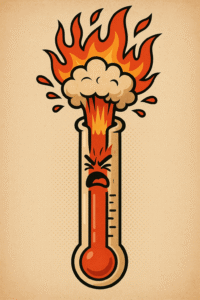 I have been increasingly discussing new UK daily records on Facebook. This year, as summer has progressed and the weather has become hotter, people are noticing. Here’s a list of …
I have been increasingly discussing new UK daily records on Facebook. This year, as summer has progressed and the weather has become hotter, people are noticing. Here’s a list of … - Summer 1976 in Durham (Phew what a Scorcher)
 A Legendary Summer The summer of 1976 is legendary in the UK. It is often talked about as being ‘The Best Summer Ever’. As a 16 year old kid, there …
A Legendary Summer The summer of 1976 is legendary in the UK. It is often talked about as being ‘The Best Summer Ever’. As a 16 year old kid, there … - The last ‘coldest’ instance for each month at Durham
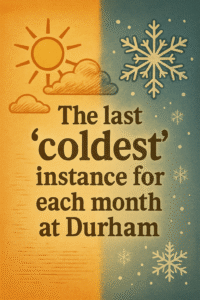 As some of you might have noticed, the World is getting warmer. As that happens, statistically we begin to notice that the distribution of cold/warm months are no longer scattered …
As some of you might have noticed, the World is getting warmer. As that happens, statistically we begin to notice that the distribution of cold/warm months are no longer scattered … - April 1917 – The Coldest April at Durham
 April 1917 – Perishingly cold at Durham Towards the end of World War 1, with fighting still going on in the trenches of France, April 1917 was quite extraordinary and …
April 1917 – Perishingly cold at Durham Towards the end of World War 1, with fighting still going on in the trenches of France, April 1917 was quite extraordinary and … - Top 10 severe weather events in North East England
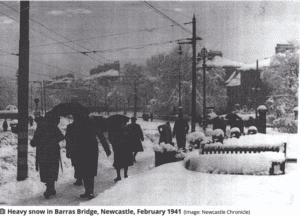 Severe weather events in Durham, North East England Just for a bit of fun, I asked ChatGPT to compile a Top 10 of severe weather events for North East England. …
Severe weather events in Durham, North East England Just for a bit of fun, I asked ChatGPT to compile a Top 10 of severe weather events for North East England. … - Wettest days in Durham
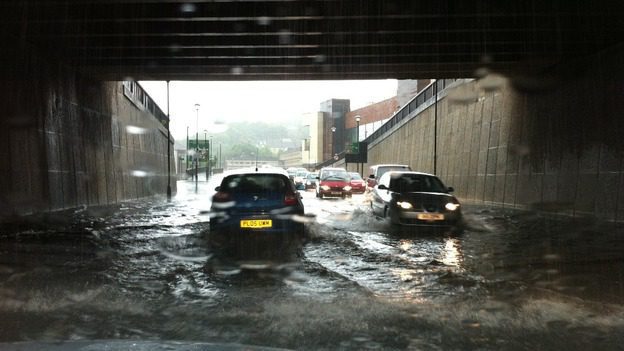 After the heavy rain of 14th August 2023, I set about looking back on days with similar totals in Durham since I started recording here. The total for 14th August …
After the heavy rain of 14th August 2023, I set about looking back on days with similar totals in Durham since I started recording here. The total for 14th August …
